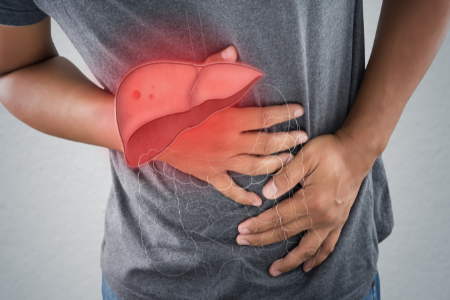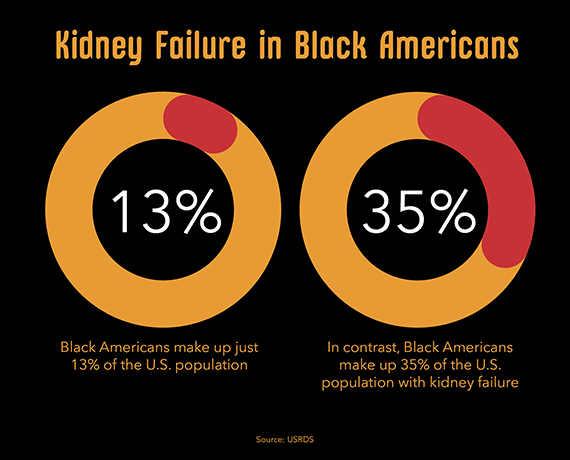liver disease
REclaim your health
Lifestyle changes can reverse liver disease and help you life longer.
Liver Disease
Reclaim your health
Lifestyle changes can reverse liver disease if caught early.
What is chronic liver disease?
- Chronic liver disease is a progressive deterioration of liver functions. Liver functions include the production of clotting factors and other proteins, detoxification of harmful products of metabolism, and excretion of bile.
- Chronic Liver Disease is a variety of diseases in which scar tissue (cirrhosis) replaces healthy liver tissue, which stops the liver from functioning properly.
- Number of adults with diagnosed liver disease: 4.5 million
symptoms
- Skin and eyes will appear yellow (jaundice)
- Abdominal pain and swelling
- Swelling in the legs and ankles
- Itchy skin
- Dark urine color
- Pale stool color or bloody/tar-colored stool
- Chronic fatigue
- Nausea or vomiting
- Loss of appetite
- Bruising easily
Risk Factors
- Unhealthy alcohol use
- Injection drug use
- Obesity
- Diabetes
- Unprotected sex
- Blood transfusion before 1992
- Exposure to other people’s blood and body fluids
Ways to Prevent
- Drink alcohol in moderation. This means 1 drink per day for women and 2 drinks per day for men.
- Get vaccinated against hepatitis A and hepatitis B
- Maintain a healthy weight
- Avoid contact with other people’s bodily fluids. This means wearing a condom during sexual contact and abstaining from sharing needles.
Types of liver disease
Virus-Related Diseases: Hepatitis A, Hepatitis B, and Hepatitis C can all lead to liver disease. Hepatitis is an inflammatory condition of the liver, and each type can be contracted differently.
Hepatitis A is contracted through consumption of food or water that has been contaminated with the virus. It is usually acute (short-term illness).
Hepatitis B is contracted through contact with infected bodily fluids including blood, vaginal secretions, or semen. It can be acute or chronic (long-term illness).
Hepatitis C is contracted through direct contact with infected bodily fluids, typically through injection drug use and sexual contact. It mostly spreads by direct blood to blood contact and is almost always chronic.
Fatty Liver Disease: Fatty liver disease is when there is a build-up of fat in and around your liver. There are two types of fatty liver disease:
Nonalcoholic Fatty Liver Disease (NAFLD) is caused by a variety of metabolic syndromes, including high blood pressure, high cholesterol, insulin resistance, and obesity.
Alcohol-Related Fatty Liver Disease (ALD) is caused by extended overconsumption of alcohol. In the early stages of disease, symptoms can typically be reversed once alcohol consumption decreases.
Liver cancer: Cancer that begins in the cells of the liver. The cells develop mutations in their DNA and begin to multiply out of control, causing a tumor/mass of cancerous cells.
Testing and treatment
Testing:A group of blood tests called liver function tests can be used to diagnose liver disease. Other blood tests can be done to look for specific liver problems or genetic conditions. Imaging tests. An ultrasound, CT scan and MRI can show liver damage.
The liver function tests typically include alanine transaminase (ALT) and aspartate transaminase (AST), alkaline phosphatase (ALP), gamma-glutamyl transferase (GGT), serum bilirubin, prothrombin time (PT), the international normalized ratio (INR), total protein and albumin.
Treatment for liver disease can vary based on the severity of the disease. Some treatment options include:
- Stopping alcohol consumption and losing weight can treat some forms of liver disease
- Diet changes
- Medication
- Surgery
- In severe cases, a liver transplant may be necessary
What to do if you are at risk?
Visit you primary care provider for a checkup and blood test.
You may be referred to a:
hepatologist– a doctor who specializes in the liver, gallbladder, bile ducts, and pancreas
gastroenterologist– a doctor who specializes in digestive disorders including liver disease
Further testing such as a liver biopsy, liver function test, or imaging test may need to be done

STATISTICS FOR PEOPLE OF COLOR

- People of color, specifically African Americans and Mexican-Americans, have a greater risk for developing liver disease than caucasians.
- The prevalence of obesity, diabetes, and Hepatitis B and C within the African American community are the contributing factors to the elevated risk of Liver Disease.
- Among African Americans, chronic liver disease is a leading cause of death. While the cause is not always known, some cases can be initiated by conditions such as chronic alcoholism, obesity, and exposure to hepatitis B and C viruses.
- In 2019, chronic liver disease was the eighth leading cause of death for non-Hispanic blacks, ages 45-64 years old.1
- African American/black men are 60 percent more likely to have liver and IBD cancer and to die from this disease as compared to non-Hispanic white men.
- African American/black women are 30 percent more likely to die from liver and IBD cancer than non-Hispanic white women.
Learn more about the Stats at GRAAHI's Health Equity Index
Links, Tools, Resources
https://liverfoundation.org/for-patients/about-the-liver/health-wellness/nutrition
https://bmcgastroenterol.biomedcentral.com/articles/10.1186/s12876-020-01392-y
https://www.ncbi.nlm.nih.gov/pmc/articles/PMC4462194/
Grand Rapids/Kent County/Michigan Resources:
https://www.medifind.com/specialty/hepatology/US/MI/Grand%20Rapids
https://www.woodtv.com/news/grand-rapids/w-michigan-doctors-watch-for-liver-illness-in-children/
Latest Advances, Clinical Trials & Breakthroughs in Chronic Liver Disease
https://www.ncbi.nlm.nih.gov/pmc/articles/PMC7194462/
https://medicine.yale.edu/news-article/yale-liver-center-anticipates-future-advances-in-liver-care/
https://academic.oup.com/stcltm/article/11/9/900/6673063